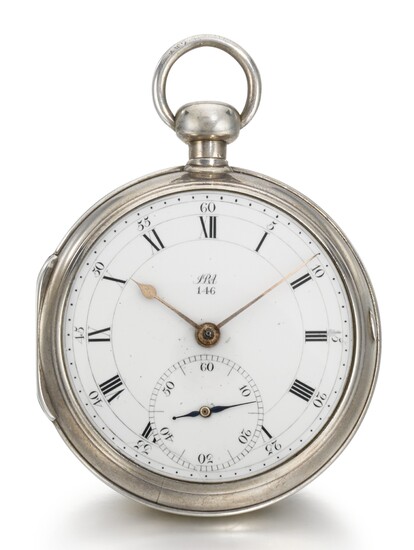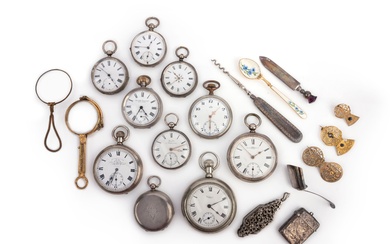John Arnold & Son, London
SILVER CONSULAR-CASED POCKET CHRONOMETER WITH ARNOLD SPRING DETENT AND STEEL ESCAPEMENT NO. 146 CIRCA 1796
John Arnold & Son, London
Dial: white enamel, signed JRA, Roman numerals, outer five minute divisions with Arabic numerals, large subsidiary seconds
Movement: gilt full plate fusée, ‘Arnold type’ spring detent escapement, foliate engraved balance cock, Z balance and gold helical balance spring, modified temperature compensation steel escapement, diamond end-stone, signed John Arnold [& Son removed] London, Invt. Et Fec No 146
Movement number: 146
Case: plain silver polished consular case with later stem and bow, the back with fixed cover with winding aperture, inner and outer cases London hallmarked for 1796, stamped with maker’s mark TH for Thomas Hardy
Dimensions: 55.5mm diameter
Signed: dial signed JRA, movement signed John Arnold [& Son removed]
Accessories: none
Provenance:
John Roger Arnold apprenticed to his father John Arnold, the great chronometer maker and inventor, in 1783 at the age of 14. At the age of 18 and before the completion of his apprenticeship, his father took him on as a partner. John Arnold then sent his son to train as a watchmaker in Paris under his esteemed friend and colleague, Abraham-Louis Breguet. John Roger returned from Paris a year later and, in June 1796, was made a Freeman of the Clockmakers’ Company, and became Master of the Clockmakers’ Company in 1817. Together, father and son formed the company Arnold & Son, which upon John Roger Arnold’s death in 1843, was bought by Charles Frodsham.
The immediately preceding Arnold pocket chronometer to this one, No.145, has the same signatures on both the dial and movement. The updating of the temperature compensation accounts for the modified signature on both No. 145 and No.146.
For an illustration of the John Roger Arnold No.145 with the same signature, as well as information on the transfer of the business between father and son, see Hans Staeger, “100 Years Of Precision Timekeepers,” pp. 170, 189 and figs. 1-3. Staeger writes that, ‘according to an existing record written by John Roger Arnold and sent to Breguet in Paris 1796, that his father John Arnold, had transferred the running of the business to his son John Roger Arnold. However, according to existing documents, the transfer took place on the 10th May 1799.’ During this three-year period between the letter to Breguet and the transfer of the business, dials of marine chronometers and pocket watches have been found with the ‘conjoined’ J.A.R initials.
With thanks to Rory McEvoy and Jonathan Betts for their help with this footnote.
View it on
Estimate
Time, Location
Auction House
SILVER CONSULAR-CASED POCKET CHRONOMETER WITH ARNOLD SPRING DETENT AND STEEL ESCAPEMENT NO. 146 CIRCA 1796
John Arnold & Son, London
Dial: white enamel, signed JRA, Roman numerals, outer five minute divisions with Arabic numerals, large subsidiary seconds
Movement: gilt full plate fusée, ‘Arnold type’ spring detent escapement, foliate engraved balance cock, Z balance and gold helical balance spring, modified temperature compensation steel escapement, diamond end-stone, signed John Arnold [& Son removed] London, Invt. Et Fec No 146
Movement number: 146
Case: plain silver polished consular case with later stem and bow, the back with fixed cover with winding aperture, inner and outer cases London hallmarked for 1796, stamped with maker’s mark TH for Thomas Hardy
Dimensions: 55.5mm diameter
Signed: dial signed JRA, movement signed John Arnold [& Son removed]
Accessories: none
Provenance:
John Roger Arnold apprenticed to his father John Arnold, the great chronometer maker and inventor, in 1783 at the age of 14. At the age of 18 and before the completion of his apprenticeship, his father took him on as a partner. John Arnold then sent his son to train as a watchmaker in Paris under his esteemed friend and colleague, Abraham-Louis Breguet. John Roger returned from Paris a year later and, in June 1796, was made a Freeman of the Clockmakers’ Company, and became Master of the Clockmakers’ Company in 1817. Together, father and son formed the company Arnold & Son, which upon John Roger Arnold’s death in 1843, was bought by Charles Frodsham.
The immediately preceding Arnold pocket chronometer to this one, No.145, has the same signatures on both the dial and movement. The updating of the temperature compensation accounts for the modified signature on both No. 145 and No.146.
For an illustration of the John Roger Arnold No.145 with the same signature, as well as information on the transfer of the business between father and son, see Hans Staeger, “100 Years Of Precision Timekeepers,” pp. 170, 189 and figs. 1-3. Staeger writes that, ‘according to an existing record written by John Roger Arnold and sent to Breguet in Paris 1796, that his father John Arnold, had transferred the running of the business to his son John Roger Arnold. However, according to existing documents, the transfer took place on the 10th May 1799.’ During this three-year period between the letter to Breguet and the transfer of the business, dials of marine chronometers and pocket watches have been found with the ‘conjoined’ J.A.R initials.
With thanks to Rory McEvoy and Jonathan Betts for their help with this footnote.




